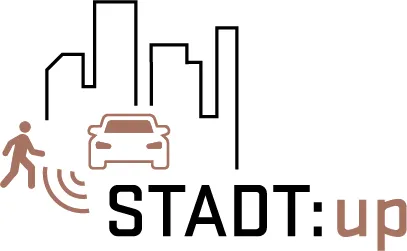STADT:up – Solutions and Technologies for Automated Driving in Town: an urban mobility project
Project Description
In the STADT:up project, tailored concepts and pilot applications of continuous automated driving in urban areas are developed based on the needs of users. The focus is on the implementation of new, AI-based methods and their demonstration in automated driving systems, especially in complex traffic situations. Vulnerable road users, complex intersections, and automated merging and avoiding obstacles are given special consideration.
The project takes into account the entire chain of events: perception, fusion, localization, environment model, prediction, interaction, and cooperation, all the way to behavior and maneuver planning. The goals are to detect the dynamic and static environment and to define and deal with uncertainty in these two categories, as well as to provide highly available and robust adaptive trajectory planning based on multi-modal predictions of all road users. The project also includes a differentiated consideration of the interaction and communication concepts between users, vehicle, and other road users during automated driving operation. This includes the situational adaptivity of control concepts and the situational and experience-dependent change in user behavior.
In addition, realistic concepts and perspectives for future intermodal mobility are developed, involving all stakeholders: cities, users, research institutions, and the automotive industry. A central question is how mixed traffic in cities, including pedestrians, cyclists, privately or shared-use vehicles, and public transport, will evolve in the future. Possible influences, such as the strengthening of regionality and the development of local city centers, the change in urban infrastructure, or the changing mobility behavior of users, such as through home office or growing energy and resource awareness, will be considered.
Tasks of the Chair
The goal of TUM-VT in the STADT:up project is to integrate intermodal mobility and automated driving into the planning philosophy of individual cities and into the urban mixed-traffic system as a whole, and to promote sustainability and a shift in transportation. To achieve this, TUM-VT in TP1 specifies the needs of various stakeholders (citizens, cities, mobility providers, technology partners) by developing an integrated dialogue forum and building a digital twin of "intermodal urban mobility."
Furthermore, TUM-VT studies and develops solutions for behavior and maneuver planning of automated driving in specific critical traffic situations, where interaction with VRUs (vulnerable road users) in mixed traffic is required, such as at dynamic stops defined by autonomous shared mobility vehicles in traffic areas and at construction sites (TP4). Special user-centered interaction and cooperation concepts for specific VRU groups will also be considered.
The developed driving functions and interaction concepts are prototypically implemented in TP5 in the TUM-VT test vehicle. This is how TUM-VT aims to promote seamless and society-oriented automated driving in the city.
| Keywords | Automated vehicles, interaction with vulnerable road users, driving behavior, driving simulator studies, test field for urban automated and connected driving |
| Funding | Federal Ministry for Economic Affairs and Climate Action |
| Website | |
| Partners | 3DM, Aptiv, AVL, BASt, CARIAD, CAT, CAM, DS, DENSO, DLR, ES, gestigon, HELLA, HM, MB, Opel, Bosch, TUC, TUDa, TUM-LfE, TUM-VT, Valeo, ZF |
| Duration | January 2023 – December 2025 |
| Contact | Lisa Kessler, Mathias Pechinger, Ulrich Glöckl, Yunfei Zhang, Santiago Alvarez-Ossorio Martinez, Mario Ilic |
